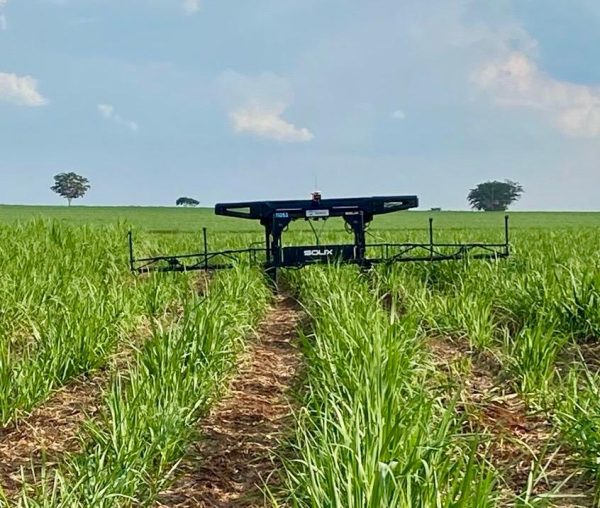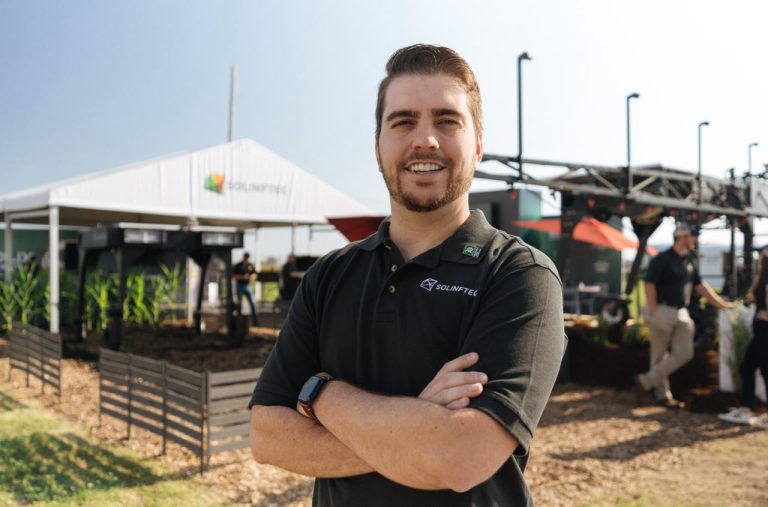São Paulo – A robot to help agricultural production to be more sustainable, save costs, and cut emissions. This is the innovative proposal brought by Brazilian company Solinftec with the Solix Ag Robotics platform, which aims to support rural producers and the environment with real-time, 24/7 data.
This is the first autonomous, electric, and solar-powered robot for large-scale food production, covering areas of up to 200 hectares. It performs localized spraying, controls weeds at an early stage, prevents pests without chemicals, saves herbicides by up to 95%, diminishes the carbon footprint in agricultural production, and enables low-impact, high-yield agriculture. The innovation was launched for the production of sugar cane and is currently also used in maize, soybean, wheat, and cotton, among others.

In an interview with ANBA, Solinftec’s chief Global Strategy officer, Léo Carvalho (pictured above), said the company, founded in Brazil by Cuban partners, was established in 2007 with innovative services. “The partners came from Cuba in the mid-2000s and were providing services in the sugar-energy sector when they found an opportunity in agriculture and began to undertake, offering solutions to monitor agricultural machinery automatically, through an on-board computer that collects real-time data,” said Carvalho.
From this basic on-board computer technology, the partners developed other layers of solutions to ensure, for example, the improvement of logistics when cutting sugar cane and the traceability of the stalk until it is processed and created meteorological stations to monitor the weather and climate, that are interconnected to other equipment, without human interference.
“Today, we have 95% of the sugarcane market share. Nearly all sugar in Brazil is tracked by our solutions. This client base is very robust and has enabled us to migrate to other agribusiness sectors, so currently, we also operate with grains, fiber, orange, coffee, and other types of crops that also use this technology to make decisions in real-time. It is an exciting technology because with more efficiency, firstly, producers save costs – whether large, small, or medium, which are the most important because they are the ones who pay for the solution – and also become environmentally efficient, optimizing productivity, and reducing the carbon footprint and emissions. In 2023, customers using our technology prevented the emission of over 430,000 tonnes of carbon dioxide,” he said.
Until 2022, Solinftec did not have an agronomic layer in its technology. “What is an agronomic layer? Our information comes from a machine because the on-board computer is inside a machine, but agriculture is very dynamic – climate, soil, and plantation conditions can change from one day to the next. We saw that we were missing some information, so we came up with the idea of creating an autonomous, electric, and environmentally friendly robot for the countryside. It can collect all the data on the crop stage, whether there are any pests or infestations, and supports us to act in real-time, as in addition to monitoring and carrying out analyses, the robot can also apply chemical products in a localized manner, i.e., it is a new concept for agriculture because it reduces the use of chemicals in the field by more than 90% and does not use fossil fuels,” said Carvalho.

The company was invited to lecture in Rome last year at the United Nations Food and Agriculture Organization (FAO) headquarters in a panel on sustainable technologies in the agricultural mechanization environment. At the 2023 UN Climate Change Summit (COP28) in Dubai, Carvalho spoke about Solix Ag Robotics in panels hosted by the Brazilian National Confederations of Industry (CNI) and Agriculture (CNA).
“This new concept is driving Solinftec to be invited to participate in lectures at the UN and COP28 – a disruptive concept for agribusiness. If we can eat today, it is because of chemicals and large-scale machinery, but we understand that this is not the way to produce more food in the future. We understand that the robotics and artificial intelligence (AI) part is the future,” he said.
Solix also has a light frequency that simulates pheromones and attracts insects from the plantation, eliminating them through electric shock at night without pesticides and saving costs. “Today, the highest agricultural cost is in inputs to prevent diseases or infestations, so this is the path we are taking,” he said.
Carvalho explained that, in conventional agriculture, analyses in the field are made over a longer window of time, generally monthly, and decisions are made for the entire plantation, for example, spraying over the whole farm using a massive amount of chemicals. Meanwhile, the robot is on the farm 24/7, using a much smaller amount of chemicals, with precise applications in specific locations. “We can predict issues and reduce the amount of inputs used. Then, it is possible to use cheaper products that do not have a patent, which further saves costs,” he said.

Weighing less than a tonne, three meters high, and with a 12-meter-long bar, the Solix Robot costs between BRL 200,000 and BRL 250,000 (about USD 40.500 to USD 50.600 at the current rate). “We wanted to make technology very democratic and accessible. Today, a sprayer costs around BRL 4 million (about USD 810.200), so that machinery would probably only get paid off by the next generation. Our robot costs a fraction of that amount. We want small producers also to have access to this technology, be efficient, sustainable, and be able to pay for this product in the first harvest,” he said.
In addition to being sustainable, efficient, and affordable, the robot’s concept, according to Carvalho, is to be easy to maintain. “I want producers to look at the robot and say: I understand what’s here, it’s not a NASA rocket, I can change this nozzle, this battery with ease,” he said.
Each robot can monitor, on average, 200 hectares in a week. “Every seven days, it will return to the same point it analyzed and rechecked the information. The seven-day cycle is the biological cycle of the plant,” he said. The robots serve large producers, like Maggi, and small ones of up to 100 hectares.
The Solix Ag Robotics technology operates mainly on farms in Brazil, the United States, Canada, and a few in Colombia, Peru, Argentina, Guatemala, and other countries in Latin America. There is a 500-farm-long waiting list to obtain the solution.
The company is based in Araçatuba, in the countryside of São Paulo state, where the robots are finished. Another factory also manufactures robots in Indiana, USA. “We have China as a technological support hub – we do research and development there, and the robot’s main sensors were developed there. We receive the parts and assemble them here,” he said.
Carvalho said he is constantly studying new markets, such as the United Kingdom and France, and that after Dubai’s COP28, he visited farms in Sudan and Egypt.
Translated by Elúsio Brasileiro




